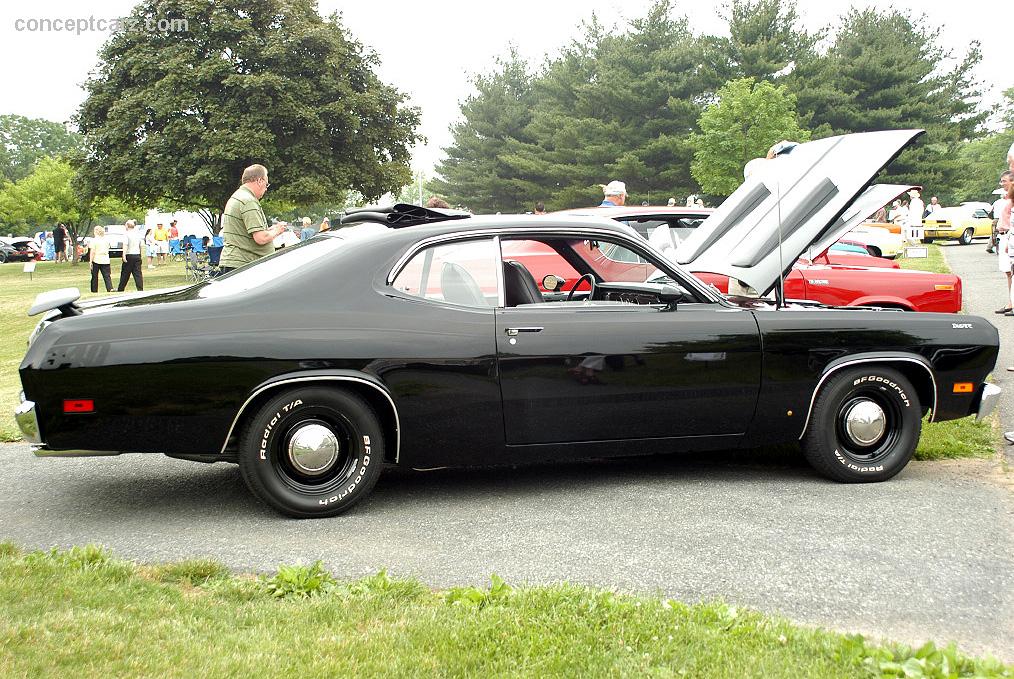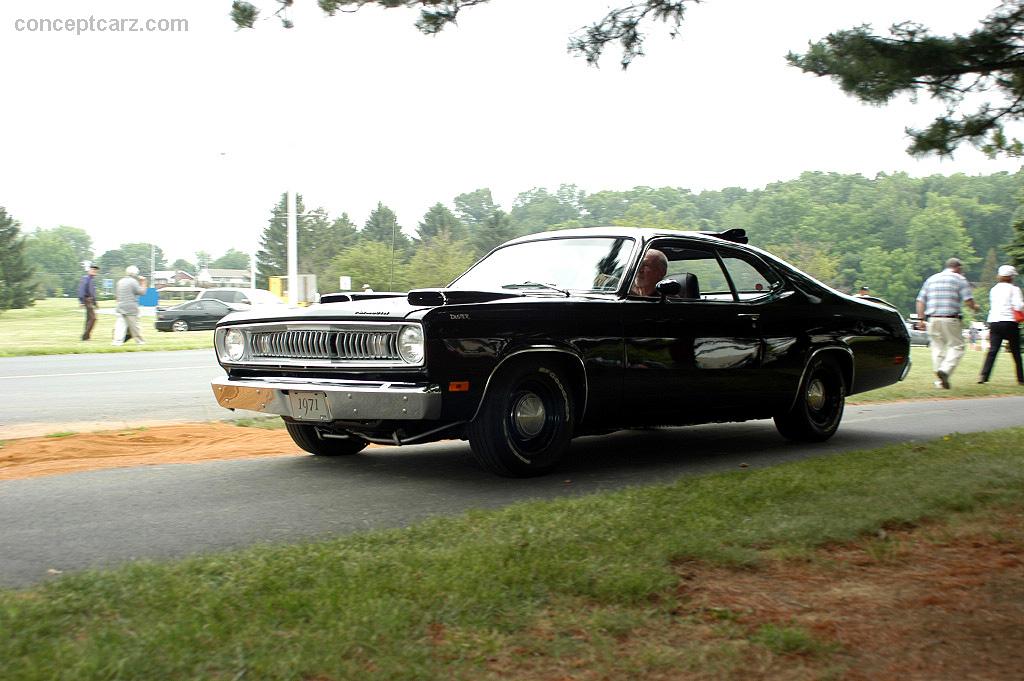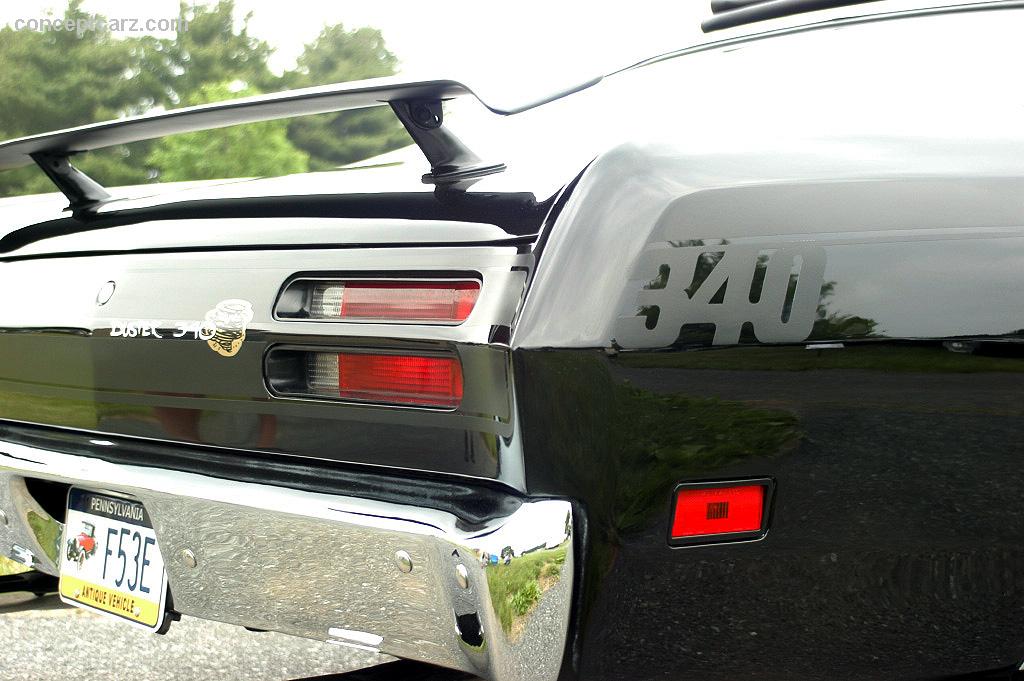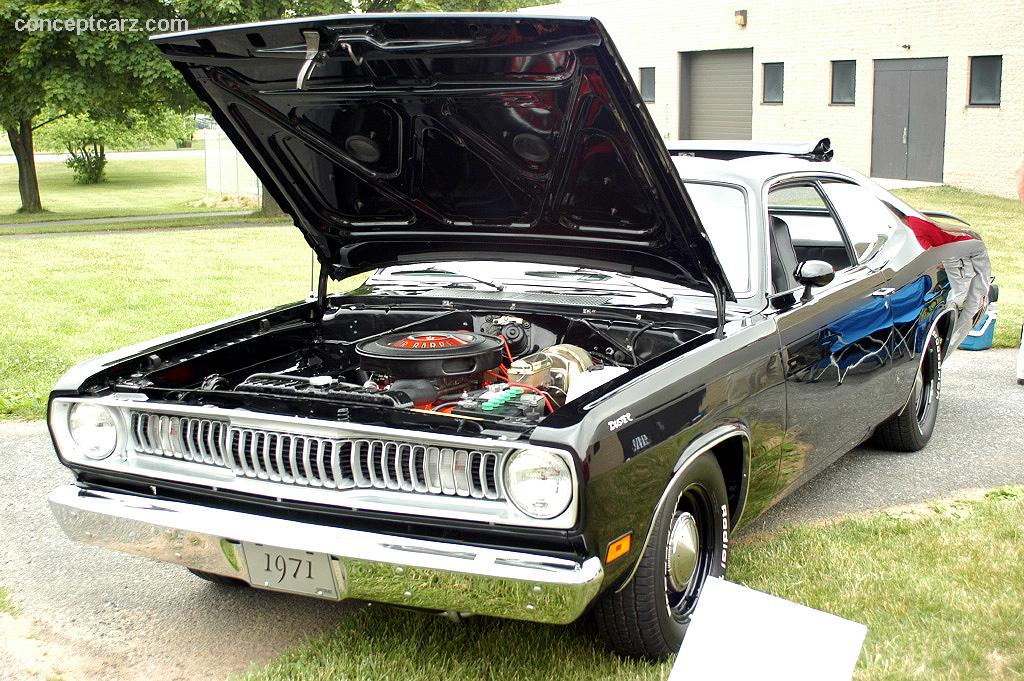The Valiant was given a facelift for 1970 and used it to create a new car called the Duster. The Duster used many of the components from the Valiant, including the chassis. Though this had been an unauthorized project, the Duster was put into production and win over the hearts of many buyers. The small footprint and lightweight persona helped spawn a high-performance version of the Duster, the Duster 340. Not a new concept, the Duster 340 was based around the small-block Chrysler engine that had been introduced a few years earlier. 
Six Cylinder Coupe
View info and historyThe late 1960s was the height of the muscle car movement and the Duster 340 was a worthy contender. It was given subtle design cues such as striped down its sides and small 340 decals. After proving its potential during its initial year of production, the designers decided to shed some of its 'sleeper' persona and advertised its 'muscle car spirit' by adding bigger stripes with '340' callouts on the quarter panels. Hood scoops and optional trunk spoilers also meant this was more than just an economical means of transportation. A 'Performance Hood' was available which blackened out the hood and added '340 Wedge' decals. In the front was a new grille that had thin horizontal slats painted black. For 1971, the Valiant 4-door sedan sold for just under $2400 and 24,660 examples were sold. The Duster 340 sold for $2,700, and just 12,886 were produced. The base version of the Duster was priced at $2,310 and an astounding 173,592 were sold. 
Six Cylinder Coupe
View info and historyThe Valiant and Duster came standard with an overhead valve six-cylinder engine which had 125 horsepower. An optional V8 was available for both models, displacing 318 CID and offering 230 horsepower. The Duster 340 was fitted with a 340 CID V8 that produced 335 horsepower and fitted to a four-speed manual gearbox. Bob McCurry, the Dodge Davison's general manager was not too fond of the Plymouth Valiant line outselling the Dodge Dart line, demanded a variant of the Duster for his Dart. The result would be the Dodge Demon (later Dart Sport), which never achieved the same popularity as its Duster cousin.
by Daniel Vaughan | Oct 2012

Six Cylinder Coupe
View info and history

Six Cylinder Coupe
View info and history
by Daniel Vaughan | Oct 2012
Neil Walling is credited with designing the Plymouth Duster. It was given a sloped rear, wide rear fenders, curved side glass in the windows, and a small roof. John Worthy, who worked in the Advanced Car Engineering Department, was brought in to solidify the design and verify that it could be built. The man responsible for managing the project and gaining approval for the design from the corporate management was Gene Weiss.
Six Cylinder Coupe
View info and historyThe original idea was to use the Warner Brothers Tasmanian Devil swirl cartoon but they were unable to secure the rights. So designs were drawn with their own 'Duster' or devil swirl. The name drew from the idea that when a driver lost a race they were left in the dust or 'dusted'. The car was positioned to compete with the Chevrolet Nova. In 1970 Plymouth introduced its Plymouth Valiant Duster. It could be purchased in the later part of September 1969. During its first year, Plymouth sold 217,192 Duster cars. 24,817 were outfitted with the 340 cubic-inch engine. At a base price of $2,172 the Duster was a phenomenal purchase. The base engine was a 198 cubic-inch six-cylinder engine that produced 125 horsepower. The 225 cubic-inch six-cylinder engine raised the horsepower rating to 145. Two 8-cylinder engines were available, the 318 and 340 cubic inch. The 318 produced 230 horsepower while the 340 produced 275. With the 340, the Duster could race from zero-to-sixty mph in the low 6's with the quarter mile time of around 14.7.
The Duster featured unibody construction, Torqueflite automatic, optional disc brakes, front torsion bar suspension, and four engines to choose from. The interior could be outfitted with bench or bucket seats. The instrumentation was complete and an optional tachometer was available as optional equipment. In 1971 Plymouth introduced the Twister package which included Rallye wheels, bucket seats, unique grille, racing mirrors and more as standard equipment. The engine options remained the same.
Six Cylinder Coupe
View info and historyIn 1972 the compression was reduced to 8.5:1 on the 340 cubic-inch engine. Horsepower was now rated by the SAE standard, meaning the 340 cubic-inch 8-cylinder engine was rated at 240 horsepower. The Twister trim was carried over from the previous year but did not retain its unique grille and hood. The 198 cubic-inch slant six engine was dropped. The 225 cubic-inch six-cylinder engine producing 145 horsepower was now the base engine. The 318 produced 230 horsepower and the 340 produced 240 horsepower. After 100,000 units had been sold, Plymouth introduced the Gold Duster option package. In 1973 the Duster received styling changes. The taillights were modified and the vehicle received a new grille. The back seats were now able to be folded down, allowing ample cargo space. These models were known as Space Dusters, due to the extra space that they provided. The bumpers were updated to comply with Federal safety regulations. 15,731 customers purchased the Duster 340 in 1973. The 225, 318, and 340 engines were offered.The marketplace was shifting and the world was experiencing a fuel shortage. The price of gasoline skyrocketed and the public reacted by searching for economical, fuel-efficient vehicles. The automobile manufacturing companies responded by offering smaller engines. After the oil embargo crisis was over, the public was back to buying the larger engine vehicles.
Six Cylinder Coupe
View info and historyIn 1974 Plymouth introduced the 360 cubic-inch eight-cylinder engine in the Duster model line, as a replacement for the 340. The 360 engine produced 245 horsepower and was fitted with a Torqueflite transmission. 3,979 examples of the Duster 360 were purchased. Even though the 360 engine had a larger displacement, it also was heavier, ultimately degrading the performance when compared with the 340.
1974 turned out to be the best sales year for the Duster. In 1975, the Twister option was no longer offered. The 360 cubic-inch engine was detuned and now produced 230 horsepower. The 318 produced 230 horsepower while the base 225 six-cylinder engine produced 145 horsepower.In 1976 Plymouth introduced the Volare and Dodge introduced their Aspen. They were immediately popular with the public and this had a negative impact on the sale of the Duster. To rejuvenate sales, Plymouth introduced the Silver Duster package which did little but add to the visual appeal of the vehicle. A Feather Duster was introduced which replaced many of the body components with aluminum, resulting in nearly 200-pound weight loss for the vehicle. It was outfitted with the six-cylinder engine, special exhaust system, and promoted as a light-weight, fuel-efficient vehicle. A Spirit of 76 edition was offered which featured a 'Spirit of 76' sticker on the rear quarter panels.
Six Cylinder Coupe
View info and historyThe 360 cubic-inch engine was detuned even further, complying with strict government regulations. Producing 220 horsepower, it had lost 10 horsepower when compared with the prior year. Production for the A-body Dusters lasted until 1976, resulting in 1,328,377 units being created. The Duster name continued to be used, built on the F-body platform and resembling its Volare counterpart.
by Daniel Vaughan | Nov 2005

Six Cylinder Coupe
View info and history
The Duster featured unibody construction, Torqueflite automatic, optional disc brakes, front torsion bar suspension, and four engines to choose from. The interior could be outfitted with bench or bucket seats. The instrumentation was complete and an optional tachometer was available as optional equipment. In 1971 Plymouth introduced the Twister package which included Rallye wheels, bucket seats, unique grille, racing mirrors and more as standard equipment. The engine options remained the same.

Six Cylinder Coupe
View info and history

Six Cylinder Coupe
View info and history
1974 turned out to be the best sales year for the Duster. In 1975, the Twister option was no longer offered. The 360 cubic-inch engine was detuned and now produced 230 horsepower. The 318 produced 230 horsepower while the base 225 six-cylinder engine produced 145 horsepower.In 1976 Plymouth introduced the Volare and Dodge introduced their Aspen. They were immediately popular with the public and this had a negative impact on the sale of the Duster. To rejuvenate sales, Plymouth introduced the Silver Duster package which did little but add to the visual appeal of the vehicle. A Feather Duster was introduced which replaced many of the body components with aluminum, resulting in nearly 200-pound weight loss for the vehicle. It was outfitted with the six-cylinder engine, special exhaust system, and promoted as a light-weight, fuel-efficient vehicle. A Spirit of 76 edition was offered which featured a 'Spirit of 76' sticker on the rear quarter panels.

Six Cylinder Coupe
View info and history
by Daniel Vaughan | Nov 2005
Similarly Sized Vehicles
from 1971
Similarly Priced Vehicles
Volkswagen 143 Karmann Ghia ($2,600-$2,600)
Dodge Dart ($2,400-$2,600)
Plymouth Barracuda ($2,660-$3,410)
Datsun 510 ($2,000-$2,370)
Chevrolet Chevelle ($2,675-$3,650)
Dodge Charger ($2,710-$3,775)
Ford Torino ($2,670-$3,561)
Triumph Spitfire MKIV ($2,650-$2,650)
Volkswagen Beetle ($1,840-$2,750)
Average Auction Sale: $21,919
Dodge Dart ($2,400-$2,600)
Plymouth Barracuda ($2,660-$3,410)
Datsun 510 ($2,000-$2,370)
Chevrolet Chevelle ($2,675-$3,650)
Dodge Charger ($2,710-$3,775)
Ford Torino ($2,670-$3,561)
Triumph Spitfire MKIV ($2,650-$2,650)
Volkswagen Beetle ($1,840-$2,750)
Average Auction Sale: $21,919
1971 Plymouth Valiant Duster Vehicle Profiles
Recent Vehicle Additions
Performance and Specification Comparison
Price Comparison
$2,660 - $3,410
$2,660 - $3,640
$3,110 - $4,145
$3,730
Related Automotive News

Volkswagen Type 4
Herndon, VA — In 1968, the iconic Beetle had been selling by the millions every year, establishing Volkswagen as one of the worlds largest exporter of automobiles. Still, continued success demanded an ever-evolving portfolio, with evolutionary...

Concours d'Elegance of America at St. John's : Best of Show
The Concours dElegance of America, established in 1978, featured over 300 significant automobiles on the beautiful green at the Inn at St. Johns in Plymouth, Michigan. This years featured classes included Vintage Bentley, Auto Show 55, Bonneville...

Thomas Scott Collection of Classic American Automobiles to be On Offer at No Reserve at Russo and Steele's 2015 Monterey Collector Automobile Auction Event
Scottsdale, Arizona (July 18th, 2015) – Thomas Scott is an accountant and entrepreneur from Athens, Georgia who has had a love for all things automotive for as long as he can remember. He possesses a lifetime of passion for buying, selling and...

CHRYSLER GROUP IN 2015, UNDER THE HOOD: MORE POWER, GREATER EFFICIENCY AND EXCEPTIONAL VALUE
Introducing the HEMI® Hellcat – Chrysler Groups most powerful V-8 ever 18th new engine added to Company lineup in less than five years
Celebrated TorqueFlite family grows by one with most robust eight-speed automatic in Chrysler Group history 15...

Auctions America Continues Successful 2013 Season with its Annual Fall Carlisle Sale
Auctions America rounds out its 2013 auction season in Carlisle, Pennsylvania, October 3-4
Two-day Fall Carlisle sale, held in conjunction with the Carlisle Events Collector Car Swap Meet %26 Corral, features a diverse roster of 300 classics, exot...
























